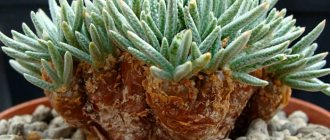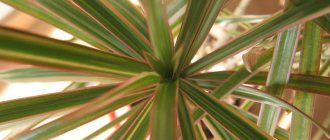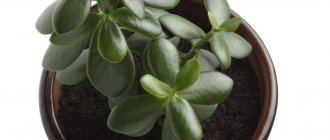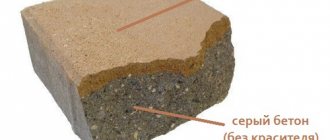About succulents
The name “succulent” itself comes from the Latin language. Translated from Latin, “succulent” means “succulent or filled with moisture.”
Succulents are a group of plants that have specific characteristics. They are characterized by the presence of thorns, thorns or juicy, fleshy leaves.
Succulent plants are able to accumulate a lot of liquid in their leaves, trunk or roots. Most perennials grow naturally in African regions. Often southern flowers have to endure heat and drought, so succulents are able to accumulate and retain the necessary amount of moisture so as not to die under the scorching rays of the sun from dehydration.
Variety of succulents
The leaves of succulent plants, despite the arid habitats of these crops, are characterized by density, juiciness and fleshiness.
The appearance of succulent plants varies depending on the type of flower.
The root system of most succulents is characterized by dense roots that can go deep underground or be located on the surface of the soil. Some exotic crops have a rather fragile root system, so when planting and replanting you need to be especially careful so as not to damage the roots.
Growing exotic crops at home is not particularly difficult, since succulents are easy to care for at home. If you follow all the rules and recommendations for caring for flowers, they can please your household and others with their blooms.
Flowering succulent stone rose
Flowering succulents are not that common, but if the plant does bloom, it can last for a long time.
When and how do succulents bloom? The flowering period depends on the type of plant. Some crops begin to bloom in late spring, others only in hot July, and there are so-called Christmas succulents, which bloom in December or January.
Christmas star blossom
Succulents have white or bright, variegated flowers, if you look at the photo during flowering.
Do succulents grow fast?
Compared to other plants, succulents grow slowly. The rate depends on the species, the conditions in which they grow, and the time of year. And, of course, speed is a subjective concept. So, whether succulents grow slowly or quickly depends on what the gardener means by these words.
Succulents, like most perennials, develop differently throughout the year. During the hibernation period, it practically does not grow. And during the period of growth it increases every day.
Spring conditions also affect the growth rate. Light, humidity, temperature and amount of watering determine how quickly succulents grow.
Signs of succulent crops
- Succulents have the same origins. Almost all of them grow in arid African countries. You can meet southern perennials in desert areas. Also, some species grow in rocky and rocky areas.
- Almost all succulent plants are long-lived and can survive for a hundred years or more in their natural habitat. It’s not for nothing that the same aloe is called “agave”. At home, succulents will not live that long, but with good care their age can reach thirty or even fifty years.
- Leaf succulents are characterized by dense, succulent leaves that can hold liquid for a very long time. This is why succulent crops can survive even in desert conditions and complete drought.
- Indoor succulent flowers are easy to care for. Also, these plants can be easily propagated in different ways: by cuttings, leaf and seed methods.
Types of succulents
Looking at the photo of succulent plants, you can see that they differ not only in name, but also in appearance. There are ordinary plants (aloe, cactus, haworthia, crassula) and unusual succulents (adenium, conophytum, pyaranthus, albuca). There are green and colored succulents.
Haworthia
Adenium
All succulents are divided into two large groups: leaf and stem succulents.
Leaf succulents
Leafy plants are characterized by the presence or absence of a stem, large and strong leaves, which can be smooth, matte (coated with a waxy coating) or covered with soft fluff to the touch. Examples of leaf succulents: sedum, haworthia, echeveria, aeonium, kalanchoe and others.
Sedum
Stem succulents
Stem plants are characterized by a pronounced compacted trunk, capable of accumulating vital moisture. Typically, stem plants are studded with thorns or thorns (cacti, spurge, adenium).
Adenium swazicum
All succulents are divided into different families: cactus, euphorbia, crassula, asphodelaceae, lily and others. Each family includes certain types and varieties of succulents, united by appearance and other characteristics.
There is another large classification of succulent crops:
- Ampelous. Ampelous succulents include sedum Morgana, ragwort Rowley, Hermine, Selenicereus Antonia and other varieties. Typically, hanging plants are planted in hanging pots, flowerpots, flowerpots and other containers.
Morgana sedum - Tree-like succulents look like small miniature trees. Tree-like representatives include Crassula, tree aloe (agagave), adenium, and aeonium.
Money tree (crassula) - Bush-like succulents look like grass or small bushes. Bush-like representatives include flowers such as sedum, spurge, and groundsel. In the photo is white-veined spurge.
Euphorbia white-veined
Among the representatives of green crops there are the most unusual succulents, distinguished by their bizarre appearance or bright colors. Desert succulents include Lithops flowers, which look like large, green stones, and Argyroderma.
Lithops
Another unusual flower is adenium, the trunk of which resembles a pot-bellied bottle. The unusual ragus Rowley has spherical leaves that look like small green peas or beads.
Godson Rowley
However, all succulents are beautiful in their own way, especially during the flowering period. Since only a well-groomed and healthy plant can bloom, it is useful for novice gardeners to know how to properly care for succulents.
Propagation of succulents
Succulents are easy to propagate, many even from leaf cuttings. These are sedums, kalanchoes, echeverias, pachyphytums. Even a small leaf that falls from a plant into the ground in a pot has every chance to take root and produce new shoots. All kinds of sedums can be propagated by stem cuttings, for example, Morgan's sedum, crassula, aloe, and stapelia.
Some succulents produce lateral shoots, which must be carefully separated and planted in the sand for rooting. But you don’t need to put succulent cuttings in water, they can quickly rot. Among succulents there are also viviparous plants, for example, bryophyllums.
Watering
Succulent plants are used to going without water for a long time, but this does not mean that the flowers do not need watering. For most succulents, the following rule applies: water only when the surface layer of the soil is completely dry. In summer, you can moisten the soil once or twice a week; in spring and autumn, several times a month is enough. During the dormant period (winter), flowers should be watered once a month or even less often if the plants are in humid air.
Succulent flowers need to be watered correctly. It is recommended to use rain or melt water. If you take water from the tap, you need to pass it through a filter or let it settle. Water for irrigation should not contain bleach or other impurities harmful to flowers. You cannot water the plants with cold or hot water; it should be at room temperature.
Succulents need to be watered at the root, that is, at the base of the trunk or stem. It is necessary to ensure that water does not get on the leaves, since southern perennials do not tolerate moisture well, they can rot. Also, after watering, do not allow water to stagnate in the soil and remain on the surface. If water stagnation occurs, this means that the soil is unsuitable for succulents, or the pot lacks drainage and drainage holes.
Water stagnation should not be allowed, otherwise the plant may rot.
How to make succulents grow faster? – 5 secrets
Succulents grow differently, some faster, some slower. But no matter how much time your particular plant requires, you can always reduce it a little. To make succulents grow faster, provide them with ideal conditions. Let the plant feel like it's at a resort!
Close proximity, but not very close
Succulents are able to survive in a small space when there are many other succulents nearby. The peculiarity of the plant creates the misconception that the plant LOVES to be in close quarters. But coping is not the same as needing. To make succulents grow faster, you need to give them enough space.
Plant roots are really good at providing the plant with all the necessary substances, even when surrounded by other plants. But when it gets too crowded, a real struggle for survival begins underground. And not all succulents are equally resilient. Moreover, with a lack of nutrients, the plant begins to devote all its energy to developing roots. There are no resources left for the growth of the upper part.
To make succulents grow faster, replant some of them. If plants remain the same size for a long time, they are most likely crowded. It is best to replant plants that are currently dormant (if there are different varieties of succulents in the pot).
Watering Determines How Fast Succulents Grow
It is probably more correct to say that adequate watering will prevent the plant from bending and growing slowly. In any case, watering plays a big role. It’s easy to overwater the plant, and it absolutely does not tolerate constant dampness and large amounts of moisture. Water the plant only when the soil is completely dry to help the succulents grow faster.
An equally important tip that determines how quickly succulents grow concerns the soil. It must have drainage. This will allow the water to pass through quickly. While when water stagnates, the plant will “suffocate”. All forces will be directed towards survival. In the best case, the root system will develop, but the top will remain the same. At worst, the leaves will turn yellow or rot along with the roots.
Straighten your roots
In a cramped pot, the roots of succulents are intertwined. With an actively growing root system (including due to the reasons described above), they intertwine even more closely, almost into nodules. Tangled roots have a harder time getting nutrients, water and oxygen from the soil. Not surprisingly, growth is also slowing. To make succulents grow faster, unravel the roots periodically.
This must be done carefully so as not to harm the root system. Do not use sharp objects such as a spatula. It is better to limit it to your two hands. Remove the plant from the pot. Gently clear the roots from the soil, untangling them as much as possible without destroying them. Place in new soil.
Plant choice determines how quickly succulents grow
Varieties of succulents grow at different rates. But when choosing a plant, it is worth considering the climate, even if the plant is at home. When growing any plant, the rule “the more the better” never works. It's the same with succulents. They need a certain amount of heat and light - no more, no less. If the climate in your region is not suitable for the chosen plant, it will grow slowly.
Fertilizers for succulents
Fertilizers and fertilizing must be used to make succulents grow faster. Plants must receive everything they need to develop. Use liquid fertilizers; they penetrate the soil more easily and are absorbed by the roots.
Apply fertilizer once a month to make succulents grow faster. Do not fertilize too often, as this may have the opposite effect. The best time to fertilize and spray is during active growth. It differs among different varieties.
- How to water succulents - everything you need to know
- 5 common mistakes in caring for succulents that can destroy the plant
Subscribe to our YandexZen channel to find out more!
Lighting
One of the conditions for proper care is proper lighting for succulents. Succulent plants love the sun very much, so you need to place the pot on the windowsill in such a way that the plant receives a lot of sunlight. Succulents such as cacti do not need to be shaded. But the same Crassula and aloe should be protected from direct burning rays of the sun, so as not to burn the leaves.
In winter, succulent flowers may not have enough light. For such situations, a special lamp for succulents will come in handy. Some novice gardeners wonder why succulents stretch upward. This happens because they don't have enough light.
It is important to know! A phytolamp for succulents is an excellent alternative to the sun. The lighting unit must be positioned in such a way that it is not too close to the flower, but the light falls directly on the flower.
Air humidity
Succulent crops love dry air. Too humid air can cause rot. Therefore, experienced gardeners do not recommend spraying succulents. Although on particularly hot days, some varieties of succulents can be given a warm shower. If the leaf plates become dirty or dusty, you can wipe the leaves with a damp cloth or rag.
From time to time, the flowers should be ventilated; to do this, you can open a window or take the flower pot out onto the loggia or veranda. Drafts and temperature changes should be avoided. If a plant has been in a hot room for a long time and then suddenly moved to a cool place, it may get sick.
Compositions from succulents
Succulents in a room can be grown in different ways: you can plant each plant in a separate pot. In this case, you can take square pots to save space.
But, if you are going to breed succulents, it is better to do it in a whole group. It is in the composition of different and so dissimilar species that all the originality of these plants, unusual for us, is manifested. For this, miniature succulents are taken; quite a lot can be placed on one windowsill, up to 60-70 species.
It is very interesting to create unique “desert corners” by planting several plants of various configurations and colors together in ceramic or plastic dishes, complementing them with one or more uneven stones.
It is advisable to sprinkle the surface of the soil in the container with sand or fine gravel. The height of the bowl should not exceed 1/3 or 1/4 of the height of the tallest plant.
To create a composition in a flat ceramic bowl, you can take a large round cactus, several lithops, or echeveria. Plant a gasteria or haworthia with a beautiful rosette nearby. In such a composition, pachyphytum with thick rounded bluish leaves resembling grapes, as well as low plants with creeping stems - sedums, monantes, crassula lycopsum - that hang their shoots from the edge of the bowl would be appropriate. This arrangement of succulents will be the envy of all your friends!
Images copyright flickr.com: himmelskratzer, sunshinesyrie, Becky in Texas, boisebluebird, yougrowgirl
Pot
Succulent crops are planted in various containers: flowerpots, pots, flowerpots, containers. The main thing is to choose the right pot for growing exotic crops. There are different shapes, sizes and types of flower pots.
- Breeding mini-flowers can be done in long pots or shallow containers.
- For hanging flowers you will need hanging vases or pots.
- For tree-like plants, you need to choose large, deep, stable pots.
The size of the pot depends on the size of the succulent's root system.
It is better to buy clay or ceramic pots; they allow air and moisture to pass through the walls well.
There should be drainage holes at the bottom of any container through which excess moisture will flow out.
How quickly does a succulent grow from a leaf?
To grow a succulent, you don't have to buy a pot of the plant. You can germinate it from a leaf. This won't take much time. Within a couple of weeks, the first roots will begin to appear. After a few months, the succulent can be planted in a pot. At best, within 2 months.
Top: Aloe, Echeveria. Bottom: Graptoveria, Kalanchoe.
Soil and fertilizers
For succulent plants, it is important to choose the right soil. For such flowers you need to use loose soil.
The soil mixture may include turf and leaf soil, coarse sand, small stones, and brick chips.
Soil disintegrants
You can also add a small amount of peat, wood ash or coal to the soil. Charcoal helps prevent succulents from rotting.
Important! When preparing suitable soil, it is important to remember the bottom, drainage layer. Drainage can consist of broken bricks, pebbles, small stones and even polystyrene foam, which will provide warmth to the soil and plant in the winter.
Houseplants should be fed periodically. There is no need to fertilize frequently; it is enough to fertilize the flowers once a month in spring and summer. There is no need to feed the plants in winter. As fertilizers, it is better to use special fertilizers intended for succulent crops and cacti. It is better to choose fertilizers that contain phosphorus and potassium. But it is better to avoid nitrogen-containing fertilizers.
How fast do different varieties of succulents grow?
The growth rate varies greatly. Some species grow instantly, while in others changes are noticeable only after six months.
Aloe
Succulents are considered one of the fastest growing plants, including everyone’s favorite aloe vera. With proper care, the succulent grows up to 15 cm per year.
Echeveria (echeveria)
It grows not so much in height as in width. It also belongs to fast-growing succulents. Over the course of a year, a small echeveria can increase by 15-20 cm. The main growth occurs in spring and summer, when it blooms.
Graptoveria
The variety is very similar to the previous one both in appearance and in characteristics. The succulent grows quickly in the spring and summer months, which is when the flowers appear. Over the course of a year, a small graptoveria can grow 13-18 cm.
Kalanchoe
The succulent is growing at an alarming rate. Especially Degremon species, tubiflora and pinnate. They grow even with minimal effort on the part of the grower.
Above: sedum. Bottom: Crassula.
sedum
Another name for the plant is Sedum. All types of this succulent grow quickly and take up all the available space. They can grow up to 30 cm in a year.
Crassula
Whether succulents of this type grow slowly or quickly depends largely on where they are grown. The plant grows better outside. A small 2-centimeter sprout can turn into a 15-centimeter tree in a year. At home, succulents do not grow so quickly - a couple of cm per year, remaining compact and neat.
Wintering
In the winter season, a period of rest begins for plants. During the dormant period, it is not recommended to propagate or replant plants; you should hold off on pruning. There is no need to feed overwintering succulents. Reduce the number of waterings to once per month or stop watering altogether. Wintering garden succulents differs only in that in the fall you can cover them with spruce wood, flooring or a plastic bag.
In an apartment in winter, additional lighting is needed for succulents to provide them with the necessary amount of light and heat. Special phytolamps for flowers are suitable for lighting. Also in winter it is necessary to protect flowers from sudden changes in temperature, from cold air, and drafts. Flower pots should be kept away from heating devices to prevent overheating of the crops.
Transfer
It is recommended to replant young succulents every year. Adult and old specimens should not be replanted often. It is enough to replant once every three or five years. You can plant or replant a flower as planned in the spring season. Plants for which the previous pot has become too small also need to be replanted. Urgent replanting is needed in cases where the plant rots, the soil begins to turn sour, or is not suitable for succulents, if the pot cracks or falls under the weight of the flower.
Flower replanting should be done carefully so as not to damage the roots and other parts of the plants. The best way to replant a crop is by transshipment. Carefully remove the flower along with the earthen lump and place it in a new container. In some cases, it is necessary to shake off the soil from the roots and inspect them; damaged and rotten roots should be cut off from healthy roots.
Attention! A thorny or poisonous succulent must be replanted while wearing protective gloves.











